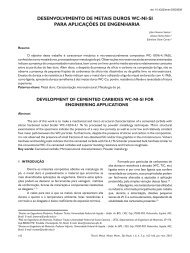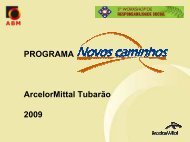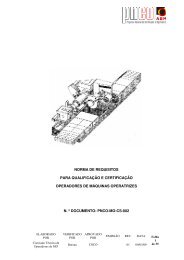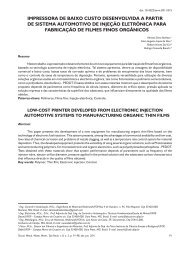Using of calcium magnesium aluminate flux with high MGO ... - ABM
Using of calcium magnesium aluminate flux with high MGO ... - ABM
Using of calcium magnesium aluminate flux with high MGO ... - ABM
- No tags were found...
Create successful ePaper yourself
Turn your PDF publications into a flip-book with our unique Google optimized e-Paper software.
Evangelista et al.chemical composition <strong>of</strong> the slag as a result <strong>of</strong> the refractorycorrosion. During the short slag sampling process, theslag surface was exposed to normal air. Slag samples wereanalysed by semi-quantitative XRF.3 RESULTS3.1 Magnesia-C Brick in Contact <strong>with</strong> Slag fromAl-killed SteelSome <strong>of</strong> the different slag practices that have beentested are shown in Table 3 <strong>with</strong> their initial composition(liquid part <strong>of</strong> the slag after 1 minute <strong>of</strong> Flux addition).The values are average analyses from the first 2 (in somecases 3) heats. The theoretical MgO-saturation has beencalculated from Equation 2 for 1600°C. As can be seenin Figure 2, Calcium Magnesium Aluminate Flux createsrapidly a liquid slag (e.g. slag A-2) in which the total MgOconcentration is increased by 2% compared to Flux A(slag C) at an addition rate <strong>of</strong> 20%. Almost all MgO isalready after 1 minute inside the liquid phase while incase <strong>of</strong> slag B practically none <strong>of</strong> the added MgO has beentransferred into liquid at this stage. Based on the average<strong>of</strong> the inner diameter <strong>of</strong> the eight MgO-C segments duringone run, it becomes obvious that CaF 2creates the strongestcorrosion (Figure 3).FLUX A represents an improvement compared toCaF 2. Significantly better is the use <strong>of</strong> FLUX B and FLUX Cwhich causes by far the lowest corrosion. In case <strong>of</strong> theslag practice <strong>with</strong> FLUX B a <strong>high</strong> initial MgO level couldbe achieved (Figure 4) and consequently only a small MgOcontent increasing has been observed after 30 minuteswhich is related <strong>with</strong> the low corrosion rate. With FLUX Cthe initial MgO content in the slag reaches very early theMgO saturation limit (Figure 5) which explains the verylow corrosion rate when FLUX C is employed. The mostsignificant increase in MgO was observed <strong>with</strong> the CaF 2practice which explains the strongest corrosion in thatcase. On the other hand a FLUX A practice shows a similarMgO dissolution but a lower corrosion rate. Here it has tobe mentioned that the corrosion pr<strong>of</strong>ile in case <strong>of</strong> CaF 2isdifferent due to the low slag viscosity which more stronglyattacks the bonds <strong>of</strong> the MgO-C brick. As consequenceMgO grains from the brick can more easily be removedfrom the brick structure by mechanical movements <strong>of</strong> theslag. (7)Figure 4. Measured initial MgO content in slag and after 30 minutestreatment time versus MgO-C corrosion rate.Figure 2. Fluxing behaviour <strong>of</strong> FLUX A (slag C; left) and FLUX B(slag A-2; right) at 1600°C.Figure 5. Evolution <strong>of</strong> MgO content in slag in contact <strong>with</strong> MgO-Cbricks as function <strong>of</strong> <strong>flux</strong> material.Figure 3. MgO/C-brick corrosion rate <strong>with</strong> different slags.These MgO grains can float as solid particles inthe slag when slag becomes saturated <strong>with</strong> MgO. Duringslag sampling <strong>with</strong> a steel rode, solid grains attached to288 Tecnol. Metal. Mater. Miner., São Paulo, v. 8, n. 4, p. 285-290, out.-dez. 2011
















